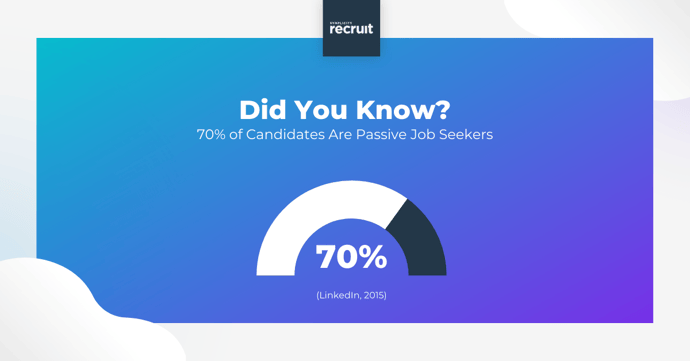You did it. You found the perfect candidate. They have the experience you’re looking for, they’re self-motivated, and they’re willing to learn. There’s only one problem. They’re not looking for a job. They’re a passive candidate.
It’s a bittersweet moment. But the reality is that roughly 37% f US workers are passive candidates so you’re bound to encounter one (or a few) at some point in your recruiting. So, what can you do?
Don’t lose hope just yet! Just because someone is a passive candidate doesn’t mean they’re opposed to the idea of switching jobs. Learning how to engage passive candidates can help extend your reach and augment your search for better long-term positive outcomes.
As the potential employer of a passive candidate, it’s your job to sell them on why your offer is better. The average time a recipient spends reading an email is about 13 seconds. That’s your time to wow them.

Benefits of Recruiting Passive Candidates
If a candidate is not active, why bother recruiting them?
Passive Candidates Are Likely to Be a Good Fit
One of the main positives about recruiting passive candidates is that you already know they’re successful at their current roles. There’s no second-guessing about their performance.
Passive Candidates Are More Eager to Make an Impact
Recent research shows that passive candidates are 120% more likely to make an impact and are already motivated to do a good job, especially when a recruiter reaches out to them with a better offer.
Moreover, for positions that require a higher level of expertise, hiring a passive candidate is a viable option. These candidates don’t need as much training and have a better grasp of the weight of their role.
How to Target Passive Job Seekers
Passive candidates are not regular candidates. Not only are they not on the job market actively looking for new roles, but they’re also not going to invest too much of their time in long-drawn-out hiring processes.

Step 1: Focus on Your Company Branding
Finding the right passive candidate is one thing, but it’s another for them to feel a connection with your company values and understand who you are. This is where your employment brand plays an important role. Three-quarters of hiring managers say that it’s easier to attract candidates when they’re familiar with the organization and their company culture beforehand.
To do this, make sure you amp up your online presence. Increase awareness of your company through outreach messages and social channels. Get employees on board to share and spread the message. The more people vouch for you, the more you validate your brand.
Step 2: Get to Know Your Passive Candidate
Before reaching out, it’s important to get a good sense of who your candidate is. This is not only to review their skills and prior work history, but to get to know who they are and what’s important to them.
Using social media channels is the best way to go about this. Pay close attention to their content. Do they subscribe to industry publications? Do they initiate thoughtful conversations on LinkedIn? Everything matters. Making sure they’re a good fit is about understanding whether their values align with your company’s and vice-versa.
Step 3: Emphasize Growth Opportunities
Passive candidates are passive for a reason. They’re not willing to upend their professional career for any offer. As a recruiter or employer, it’s your job to sell them on everything that makes this opportunity better, including growth and pay upgrades.
According to a recent study, 35% of passive employees revealed they’d consider going back to their previous position for higher pay. And although a pay increase plays a big role in a candidate’s decision to switch positions, finding long-term opportunities weighs much more. In the long run, passive candidates are more open to opportunities that will allow them to reach career goals and positions them for future professional advancement.
Step 4: Offer Candidates Work/Life Balance
In today’s job market, one thing that passive candidates value more than higher pay is good work/life balance, with 33% of passive job seekers avoiding companies that don’t prioritize this. Passive candidates will prioritize leaving an ideal position, with a good employment package, if they start to feel overworked. In today’s climate, balancing work and personal lives outweighs almost everything else.
Step 5: Ask the Right Questions
Asking the right questions can make or break a deal. It’s taken you this long to get the passive candidate’s attention. Now’s the time to focus on persuading them to consider your offer.
Here are some questions you might consider using:
- What is your dream job?
- Does your current position meet the expectations you had when you accepted?
- What do you like the most about your current role? Is there anything you’d change?
- How does the best job you ever had compare to your current position?
Be prepared. Be proactive. Be persistent.
Engaging any type of candidate, whether they’re active or passive, starts with a conversation. You may have a slot to fill in your company, but for passive candidates, these opportunities can sometimes present them with life-changing decisions.
Trust the process and focus on building trusting relationships with your candidates. In the end, if they’re happy, you’ll end up with an eager employee that’s ready to make a difference.